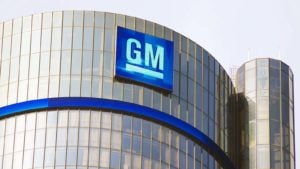Read The Full Article On: Investorplace
If you want to bet on NKLA stock, a better electric play would be General Motors
By Will Ashworth, InvestorPlace Contributor Feb 11, 2021, 11:24 am EST
I was asked to provide an update on Nikola (NASDAQ:NKLA). Instead, I can only think about how much better of an investment General Motors (NYSE:GM) would be. Recent developments have made GM stock a much better prospect than Nikola, especially following their disastrous PR stunt.

Source: Katherine Welles / Shutterstock.com
The last time I wrote about Nikola, I said it was only a buy for aggressive investors. In November, I suggested that investors wait until the electric vehicle (EV) startup got its partnership with GM straightened out.
GM Chief Executive Officer Mary Barra got things straightened out.
General Motors went from being an investor and partner building electric vehicles with Nikola to becoming a supplier of fuel-cell systems and Ultium electric batteries. In the first scenario, it was helping cash flow. But the revised arrangement was hurting it. As a result of the change, Nikola nixed the Badger electric pick-up truck.
Fast forward to February and my colleagues at InvestorPlace have the knives out for Nikola stock. Both Chris Lau and Lou Carlozo make scathing arguments against owning the company’s stock.
I’m 100% in their corner. For me, the much smarter play at this point is to buy GM stock. Here are three reasons why.
BrightDrop’s Got an Excellent Roadmap
I’ll get to my points about General Motors’ plans to be all-electric by 2035 in a bit. In the meantime, I wrote an article in January that argued Workhorse Group’s (NASDAQ:WKHS) stock would get a lot more volatile in 2021, in large part because of GM’s big push into electric commercial vehicles through BrightDrop, a separate brand the automaker’s set up to handle its expansion.
GM is working with FedEx (NYSE:FDX) and many other commercial businesses to help save them money — and save the planet.
For investors, I believe commercial vehicles will make the real money in the near-term. GM estimates the total addressable market by 2025 will be $850 billion. If Barra and company can grab a big chunk of this market, it will pay for many EV assembly plants in the future.
Now, in fairness to Workhorse, its future got a whole lot brighter when President Joe Biden signed his “Made in America” executive order in late January that, amongst other things, calls for all federal vehicles to be electric, not internal combustion.
As my InvestorPlace colleague, Louis Navellier, recently stated, Biden has put Workhorse in a prime position to win some or all of the U.S. Post Office’s contract to replace its aging fleet.
However, as Barra herself stated, the total addressable market is almost a trillion dollars. There’s plenty of room for both GM and Workhorse.
The Cadillac Lyriq Wins at the Super Bowl
During this year’s Super Bowl, one of the better commercials was GM’s ad for the Cadillac Lyriq, the luxury brand’s first of many future EVs.
“Because we designed (the Lyriq) from the ground-up with an all-new architecture, we did not just take (a vehicle) with ICE architecture and try to put a battery in it,” Lyriq chief engineer Jamie Brewer said in August 2020. “When you do that, there is always a sacrifice, and that sacrifice is usually to the customer because the vehicle was not designed to get maximum customer accommodations with a battery and drive units.”
In November, GM unveiled its plans to launch 30 EVs by 2025. As part of this plan, it will spend an additional $7 billion on EVs to meet this goal while still leaving enough to resume its dividend.
Thanks to its Ultium EV platform, the Lyriq’s coming out sometime in the first half of 2022, nine months ahead of its planned release.
Barra wants GM to be number one in North American EV market share by selling one million EVs by 2025 at margins equivalent to its internal combustion engine (ICE) vehicles.
The Business Case for GM Stock
InvestorPlace’s Dana Blankenhorn recently made the case that GM’s financial situationis better than it’s been in a long time. As such, it should not be valued at one-tenth of the market capitalization of Tesla (NASDAQ:TSLA).
In Q3 2020, as my colleague points out, GM had $35.5 billion in sales, $4 billion in net income, and $39 billion in cash sitting on its balance sheet.
“GM’s debt looks more manageable than it has in years. GM has had over $15 billion of operating cash flow per quarter through the first three quarters of the year,” Blankenhorn wrote on Feb. 3.
In January, Microsoft (NASDAQ:MSFT) announced that it was teaming up with Cruise, GM’s majority-owned self-driving business, in a partnership that will see Microsoft join GM and other institutional investors in a funding round worth more than $2 billion. The fundraise brings Cruise’s post-money valuation to $30 billion.
As part of the partnership, Microsoft becomes the preferred cloud provider for GM and Cruise.
“Microsoft, as the gold standard in the trustworthy democratization of technology, will be a force multiplier for us as we commercialize our fleet of self-driving, all-electric, shared vehicles,” Cruise CEO Dan Ammann said in a statement.
GM stock’s current market cap is about $76 billion. Let’s estimate that it owns 70% of Cruise. At $30 billion, that’s $21 billion. Back out the $39 billion in cash and GM’s operations are worth approximately $16 billion.
It had $4 billion in net income in the third quarter alone. As the world gets back to normal in 2022, $76 billion will seem very cheap.
Long term, GM stock is an excellent buy, especially when compared to Nikola.

